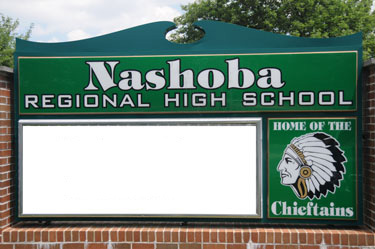
By Ann Needle
Newtown and Columbine have become places all too familiar in many parents’ minds. Protecting children from incidents like the school shootings these towns experienced has become a very visible priority for law enforcement everywhere.
Last Wednesday, the Nashoba District hosted a public forum at Bolton’s Florence Sawyer School to discuss how administration is working with law enforcement to keep students safe, and how district families can help. The discussion panel, put together by the district, included school administrators and law enforcement from Bolton and Lancaster. Stow school administration did not attend, but answered questions in separate discussions.
Though the Newtown shooting happened several months ago, Superintendent Michael Wood explained to the approximately 30 parents on Wednesday that Nashoba chose to put off a safety forum in response, “To give space since December, so parents had a chance to talk to the kids about what happened.”
While panelists highlighted some of the bigger steps the schools have taken to keep children physically safe, everyone seemed to agree that ongoing involvement between administration, students, police – and parents — is key in creating safe places to learn.
Starting with Nashoba Regional High School’s overview of its safety procedures, Principal Dr. Parry Graham noted that the high school’s outside doors are locked during school hours, with visitors buzzed in by personnel that can see who they are letting in via remote cameras. All other schools in the district follow the same procedure. Said Lancaster Police Officer Martin Gannon, if a school visitor is upset that the front door is locked, “I would rather that person be mad. I would rather be dancing with that person in the parking lot than running through the building, chasing them.”
What Graham termed “big-picture training” for staff and students comes with lock-down drills throughout the year. “You don’t want people trying to figure out what to do on the fly,” he said. Every district school conducts the drill several times a year in conjunction with their police departments.
Bolton Police Chief Vincent Alfano commented that, when his town’s schools began the drills several years ago, “They were foreign to the students, they were foreign to the staff.” Today, these exercises are part of the routine. “Any second grader can walk you through and tell you what to do, like they would in a fire drill,” he said.
Alfano stressed that the district set-up could be a big advantage in a school safety crisis. Bolton, Lancaster, and Stow police all train jointly in handling incidents arising at any of these town’s schools. Regardless of where any trouble arises, Alfano noted that the other two towns would automatically come in as back-up after hearing of the incident on police radio. “For a small town police department, that’s a huge advantage. They didn’t have that luxury in Newtown.”
The principals mentioned other physical safety measures — some put in place after Newtown — from color-coded lanyards distinguishing staff from visitors, to securing the doors to Extended Day programs at the elementary schools. Center School Principal Kevin LaCoste noted in a later conversation that Center’s Extended Day is secured after school hours.
But, panelists agreed that the schools can only do so much without making staff and students uncomfortable. “A school that is ultimately as physically safe as it can be may not be an optimal school,” remarked FSS Principal Joel Bates.
Beyond Physical Safety
While securing school buildings is vital, everyone pointed to the most important safety measure as constant contact between the schools, the police, and families.
Graham, Perkins, and Bates all gave nods to the safety committees within each of their schools. Made up of administrators and town law enforcement, these committees all meet regularly to discuss any potential issues — from a troubled student to a potentially weak spot in building security — that may come up. Both Kevin LaCoste and Hale Principal George King later mentioned they have similar committees at Center and Hale.
Still, everyone agreed that daily contact is a must between students and administration. As an example, Graham described how NRHS administration attempts to stay in contact with students throughout the day, starting with Graham greeting students as they enter the building every morning. He then circulates through the building with the two assistant principals as classes begin, “Saying hello to kids, making sure they see us.”
Graham stressed that the heart of this contact should be, “Kids feeling comfortable going to an adult, talking about something that they may be worried about, or a kid that has something on campus that they shouldn’t have.” He also stressed the importance of parents feeling comfortable contacting a school about potential safety worries. “If they call and say a kid might have drugs or a weapon, we always investigate that,” he added.
Gannon maintained that students cannot underestimate how vital it is to keep administration informed of any troubling signs in fellow students. Regarding the school shootings of the last several years, he noted, “About 65% of school shooters had indicated to one or more friends that this was imminent, either directly or through Internet postage.” He added, “If the teachers see something wrong, we tell them, trust your instincts.”
Alfano explained how, after Columbine, the police investigation turned up the padlocked bedroom of one of the shooters. The parents told investigators that their son had placed the padlock there, demanding they never enter the room. Once investigators broke in, Alfano said, “On his desk they found all his plans for making bombs, hit lists, weapons. How can a parent be told by a child, don’t come in my room? If those parents had gone into that room, Columbine may not have happened.”
While parents should respect a child’s privacy, Alfano said, “My advice regarding your children is, know them.”

